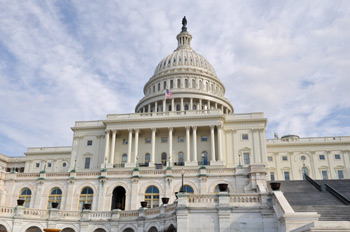Leveraging Government Opportunities
 Recently, I reviewed the financing and grant programs offered by the federal government to small business through the oversight of the Small Business Administration (SBA). Next, I’d like to review the order and sales procurement opportunities available to small businesses based on purchasing by the United States government.
Recently, I reviewed the financing and grant programs offered by the federal government to small business through the oversight of the Small Business Administration (SBA). Next, I’d like to review the order and sales procurement opportunities available to small businesses based on purchasing by the United States government.
Keep in mind
The federal government purchases billions of dollars in goods and services each year that range from paper clips to complex space vehicles. To ensure that small businesses get their fair share, statutory goals have been established for federal executive agencies. These are goals set so that small business gets its fair share of the federal spend. Of course, if small business does not bid for the order, big business wins. Here are the goals:
- 23 percent of prime contracts for small businesses;
- five percent of prime and subcontracts for small disadvantaged businesses;
- five percent of prime and subcontracts for women-owned small businesses;
- three percent of prime contracts for HUBZone small businesses; Three percent of prime and subcontracts for service-disabled, veteran-owned small businesses.
In addition to the goals established, the Small Business Act 15(g)(1) also states that it is the policy of the United States that each agency shall have an annual goal that represents the maximum practicable opportunity for small business concerns, small business concerns owned and controlled by service-disabled veterans, qualified HUBZone small business concerns, small business concerns owned and operated by socially and economically disadvantaged individuals and small business concerns owned and controlled by women.
The reality is that most small businesses are not aware of how to compete for business in an arena where they already have an advantage based on the statutory goals. So, where does a small business go to get started?
First, determine if you have a small business. The Small Business Act states that a small business concern is one that is independently owned and operated and which is not dominant in its field of operation. The law also states that in determining what constitutes a small business, the definition will vary within industries to reflect industry differences accurately. This information can be found at www.sba.gov under size regulations and shows the implementation of the Small Business Act’s mandate to the SBA. The SBA has also established a table of size standards, matched to North American Industry Classification System (NAICS) industries.
How do you identify what government procurement opportunities exist? I have modified the following information from the SBA for ease.
The government buys many of the products and services it needs from suppliers who meet certain qualifications. It applies standardized procedures by which to purchase goods and services. That is, the government does not purchase items or services in the way an individual household might. Instead, government contracting officials use procedures that conform to the Federal Acquisition Regulation (FAR).
The FAR is a standardized set of regulations used by all federal agencies in making purchases. It provides procedures for every step in the procurement process, from the time someone in the government discovers a need for a product or service to the time the purchase is complete. The FAR can be accessed electronically at www.arnet.gov/far.
As of October 1, 2001, the government transitioned from Commerce Business Daily (CBD) to Federal Business Opportunities (FedBizOpps) to post all procurement opportunities expected to exceed $25,000. FedBizOpps is a Web-based application and is the government-wide point of entry to communicate its buying requirements to potential suppliers. This very important Web site can be accessed at www.FedBizOpps.gov.
When the government wants to purchase a certain product or service, it can use a variety of contracting methods. Simplified acquisition procedures, sealed bidding, contracting by negotiation and consolidated purchasing vehicles are key contract methodologies used to purchase products and services.
The Federal Acquisition Streamlining Act (FASA) of 1994 is intended to simplify government buying procedures. It removed many competition restrictions on government purchases of less than $100,000. Instead of full and open competition, agencies can now use simplified procedures for soliciting and evaluating bids up to $100,000. Government agencies, however, are still required to advertise all planned purchases over $25,000 on www.FedBizOpps.gov.
Simplified procedures
Simplified procedures require fewer administrative details, lower approval levels and less documentation. New procurement reform legislation requires all federal purchases above $2,500, but below $100,000, to be reserved for small businesses, unless the contracting officer cannot obtain offers from two or more small businesses that are competitive on price, quality and delivery.
Government purchases of up to $2,500 in individual items or multiple items whose aggregate amount does not exceed $2,500 are now classified as micro-purchases and can be made without obtaining competitive quotes. However, these purchases are no longer reserved for small businesses. Agencies can make micro- purchases using a Government Purchase Card (typical credit card).
Sealed bidding
Sealed bidding is how the government contracts competitively when its requirements are clear, accurate and complete. An Invitation For Bid (IFB) is the method used for the sealed bid process. Typically, an IFB includes a description of the product or service to be acquired; instructions for preparing a bid; the conditions for purchase, packaging, delivery, shipping and payment; contract clauses to be included; and the deadline for submitting bids. Each sealed bid is opened in public at the purchasing office at the time designated in the invitation. All bids are read aloud and recorded. A contract is then awarded by the agency to the low bidder determined to be responsive to the government¹s needs. Government-wide IFBs are available daily for review at the FedBizOpps Web site. This electronic government service also provides a direct link to the invitation.
Contracting officials search the Central Contractor Registration to identify qualified small business contractors. Therefore, any small business that wants to sell to the government should be registered at www.ccr.gov. Contract negotiation In certain cases when the value of a government contract exceeds $100,000, and when it necessitates a highly technical product or service, the government may issue a Request for Proposal (RFP). In a typical RFP, the government will request a product or service it needs and solicit proposals from prospective contractors on how they intend to carry out that request and at what price. Proposals in response to an RFP can be subject to negotiation after they have been submitted.
When the government is merely checking into the possibility of acquiring a product or service, it may issue a Request for Quotation (RFQ). A response to an RFQ by a prospective contractor is not considered an offer, and consequently, cannot be accepted by the government to form a binding contract. The order is an offer by the government to the supplier to buy certain supplies or services upon specified terms and conditions. A contract is established when a supplier accepts the offer.
Government-wide RFPs and RFQs are available daily for review at www.fedbiz.gov. In most instances, the government uses oral solicitations for purchases less than $25,000, written solicitations for purchases over $25,000 and purchase cards to obtain micro-purchases less than $2,500.
One of the most significant changes in government acquisition reform is the increased importance of “best value.” Best value means that, rather than making awards to the lowest bidder as it generally did in the past, the government can now make awards for the item that best satisfies its needs at a slightly higher price. If purchasers are going to make an award based on best value, they must state their intent in the solicitation document and include a description of the evaluation criteria, award factors and factors other than the price that will be considered in making a contract award.
Consolidated purchasing programs
Most government agencies have common purchasing needs‹carpeting, furniture, office machine maintenance, petroleum products and perishable food supplies are just a few examples. Sometimes the government can realize economies of scale by centralizing the purchasing of certain types of products or services.
Procurement reform has ushered in numerous new and/or modified acquisition vehicles‹multiple award contracts such as multi-agency contracts and government-wide acquisition contracts (GWACs). These vehicles encourage long-term vendor agreements with fewer vendors.
The use of these contract vehicles, including expanded use of GSA schedules, has increased significantly during the last few years. These popular vehicles allow government buyers to quickly fill requirements by issuing orders against existing contracts or schedules without starting a new procurement action from scratch. Further, agencies can competitively award several or multiple task order contracts to different firms for the same products and services. This practice allows federal buyers to issue orders to any one or combination of several firms with relative ease.
The three largest interagency consolidated purchasing programs are administered by the General Services Administration, the Defense Logistics Agency and the Department of Veterans Affairs.
Clearly defining your business is important for accurate representation of your firm when submitting contract proposals. In addition, such identification can serve as a marketing strategy. Government agencies are required to establish and (strive to) meet a variety of small business procurement goals. For example, an agency may be looking for a woman-owned business to fulfill specific contract requirements and help it achieve government-wide contracting with women-owned small businesses.
As noted previously, there are goals for small business subcontracting. Subcontracting, or teaming with a prime contractor, can be a profitable experience and growth opportunity for your business. If, after assessing the capabilities and capacity of your business, you conclude that you are not ready to bid competitively for prime contracts, consider the opportunities available through subcontracting. The experience gained from performing as a subcontractor can assist you in responding to solicitations as a prime contractor. Subcontracting, however, should not be viewed only as an opportunity for less- experienced business, but also as a vehicle to enhance your qualifications to become more competitive to perform as a prime contractor.
Over the years, several laws have been passed regarding subcontracting to small business. All of these are now incorporated into Section 8(d) of the Small Business Act and, in most cases, FAR 19.7. These laws require prime contractors having contracts that exceed the simplified acquisition threshold (SAT) to provide maximum practicable subcontracting opportunities to small business, HUBZone small business, small disadvantaged business, women-owned small business, veteran-owned small business (VOSB) and service-disabled VOSB. The clause “Utilization of Small Business Concerns” must be included in all federal contracts exceeding the SAT.
These laws, among other things, require that:
- On contracts more than $500,000 (or $1,000,000 for construction of a public facility), large prime contractors and other-than-small subcontractors submit subcontracting plans containing specific percentage goals for small business, HUBZone small business, small disadvantaged business, women-owned small business, VOSB and service-disabled VOSB.
- Subcontracting plans must contain a description of the methods and efforts used to assure that small business enterprises have an equitable opportunity to compete for subcontracts.
- Subcontracting plans must be submitted by contractors for review prior to the award of any contract; failure to comply in good faith with its approved plan may subject the contractor to liquidated damages or termination for default.
The requirement to submit a subcontracting plan does not apply to:
- small businesses
- contracts under the prescribed dollar amounts
- prime contracts not offering subcontracting possibilities
- contracts to be performed entirely outside the United States
Recommendations
As a small business engaged in subcontracting, be sure you understand the terms and conditions of your contract with the prime contractor before agreeing to serve as a subcontractor. Ask the following:
- How and when will I receive compensation from the prime contractor?
- How much can I rely on the prime contractor for special tools, engineering advice, information on manufacturing methods and more?
- How will quality control and inspection procedures be applied to my subcontract?
Find subcontracting opportunities at www.web.sba.gov/subnet/.
A primary source for agencies to learn about prospective vendors is a government-maintained database (CCR/PRO-Net) of companies wanting to do business with the government, the Central Contractor Registration (CCR). This database is a marketing tool for businesses and a searchable list of prospective vendors for the government. The database provides agencies with the ability to search for companies based on their abilities, size, location, experience, ownership and more.
So where do you go with this new found knowledge? You’ve heard the expression, “You¹ve got to play to win.” Well, to succeed in government contracting, you have to register to participate.
The CCR, developed by the Department of Defense, and PRO-Net, the Dynamic Small Business Search (DSBS), developed as a database of small businesses by the SBA, have recently merged to provide a single searchable database of large and small vendors for use by agencies and vendors. The CCR contains a PRO-Net supplement, which collects and maintains specific information about and pertaining to small businesses. The CCR and DSBS are part of the Integrated Acquisition Environment (IAE), undertaken pursuant to the President’s Management Agenda for Electronic Government.
It is important that you register your business in this database. Once you have registered and found a potential product or service need you can bid on, you are ready to start. Writing procurement bids and proposals requires the utmost care.
Before preparing and submitting an offer, closely study the description of the requirement to be sure that you can meet the government¹s needs. This is critical. Particular attention should be given to the instructions of the requesting agency and to conditions of purchase, delivery and payment. When determining the amount of the offer, a small firm should be especially careful to include all costs of material, labor, overhead, packaging and transportation. Furthermore, it should be sure to comply with other important provisions of the solicitation such as properly tagging, marking and mailing any required samples well in advance of the opening date.
In addition to clearly defining your business and representing the product you are manufacturing or the service you are providing, and having a working knowledge of government contracting procedures, you should also be aware of the following:
As you have learned, the government conducts its business through authorized agents called contracting officers. Only a contracting officer has authority to bind the government, unless you are otherwise advised in writing. However, even contracting officers have limits on their authority, so do not hesitate to make sure of the authority of the person with whom you are dealing. Government procurement has historically been used as a vehicle for advancing various national, social and economic objectives. As a government contractor, you will be required to comply with the labor standards statutes (Service Contract Act, Contract Work Hours and Safety Standards Act, etc.) and other statutes advancing national socio-economic objectives, except for certain contracts where such legislation is specifically stated as non-applicable.
You should become familiar with the contract provisions protecting the integrity of the government procurement process. These provisions include the “officials not to benefit” clause, the “anti-kickback” provisions, the “gratuities” clause, etc.
Disputes between you and the contracting officer may occur under the contract. Federal contracts contain a clause setting forth procedures to resolve disputes. If the contracting officer issues a decision that is unsatisfactory to you, you must make a timely appeal or the decision becomes final. Appeals are heard by the Board of Contracts Appeal.
Do not attempt to build something bigger, better or different than called for by the contract. If you do, it may be too big or too heavy or may not fit, and the government will not accept it. Simply comply with the contract terms, particularly the specifications.
If your contract requires production, establish a production control schedule to assure that you will have the right materials in-house at the right time to meet delivery requirements. Make sure to place any subcontracts promptly and schedule delivery of subcontracted items carefully to avoid over-or-under stocking. If it appears you will not meet your schedule, notify the administration office immediately to obtain assistance. Failure to deliver on time gives the government the right to cancel your contract, with possibly disastrous results to you.
One of the first things that must be done by a small business is to market to the Federal government. The best ways to start include registering on SBA’s PRO-Net database, and contacting the agency¹s office of small and disadvantaged business utilization (OSDBU).
Being e-commerce savvy is very important in doing business with the federal government. For example, if you want to do business with the Department of Defense, you must be able to invoice and receive payments electronically. Therefore, small business owners interested in doing business with the federal government should master electronic commerce.
The U.S. government is the world’s largest buyer of products and services. Purchases by military and civilian installations amount to nearly $200 billion a year, and include everything from complex space vehicles to janitorial services to cancer research. In short, the government buys just about every category of commodity and service available.
Knowing what and how the government buys is essential if business owners are to be successful in government contracting. Don’t think, however, that you can relax once you receive the good news that you have won a contract. Your work is just beginning. If you cannot perform according to the terms of the contract, the government will not get the product or service it needs and you may find yourself in financial difficulty as well.
The first thing to do is to read the proposed contract carefully before signing it. This may look like an imposing task as some contracts may contain many pages, depending on the type of contract and complexity of what the government is buying. However, many contract terms and conditions are “boilerplate.” Once you read and understand the terms, you will be familiar with them when they appear in your next contract.
One important feature of the contract is the identity of the office that will administer it. In most federal agencies, this is usually the same office that awarded the contract. In the Department of Defense, however, the contract is generally assigned to a special administering office. If you have any questions about the contract, contact the office of administration. Do not proceed and find out much later that you are not in compliance.
There are tremendous untapped opportunities and ways to do business with the federal government. Do not take the attitude that they are too large, too difficult or too cumbersome to deal with. You can grow your business profitably and the government does pay its bills!







